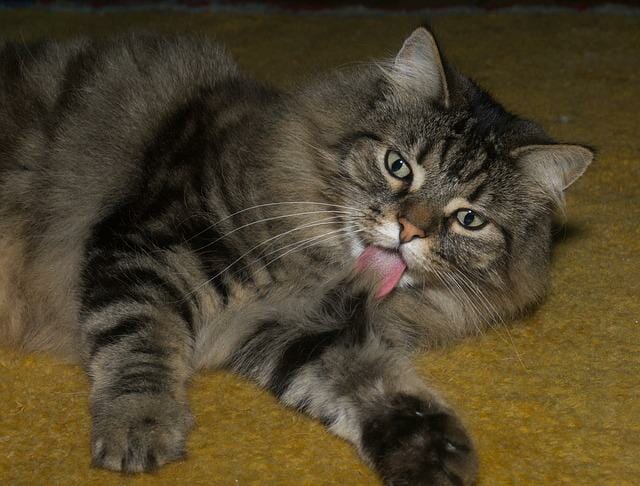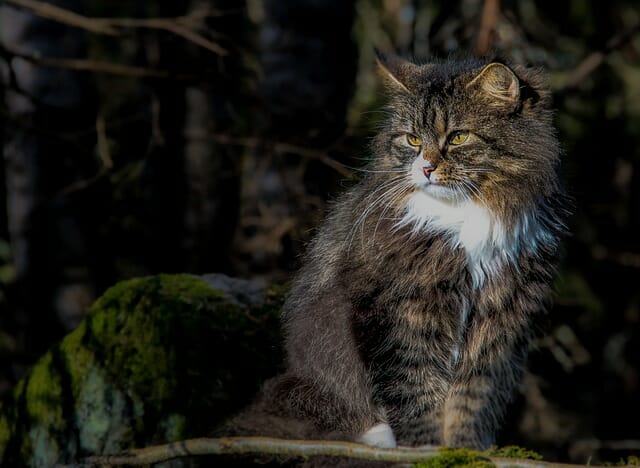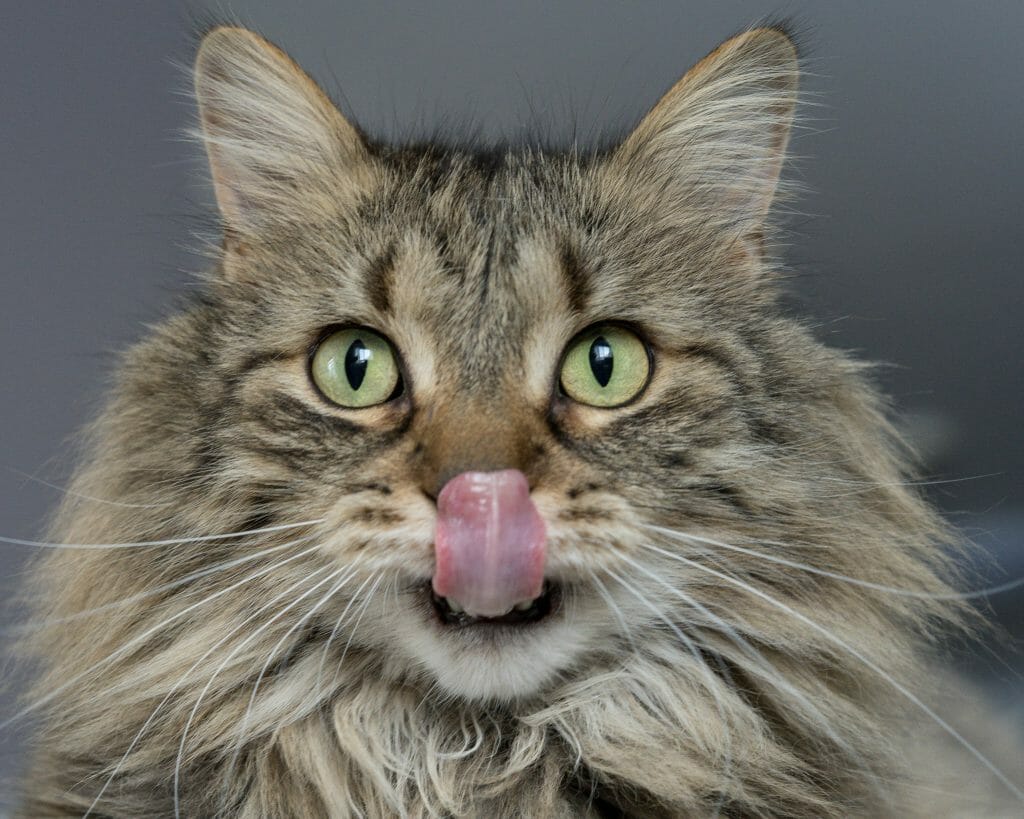What Do Norwegian Forest Cats Eat in the Wild: Understanding the Norwegian Forest Cat’s Diet in the Wild
Norwegian Forest cats are adapted to survive in the cold and rugged terrain of the Norwegian forests, where their diet mainly consists of small prey such as rodents, birds, and fish. In the Wild, Norwegian Forest cats are natural hunters with a strong instinct to catch their food.
They are known to be skilled hunters and can catch animals larger than themselves, such as rabbits and small deer. They are highly adaptable and can survive on a variety of different foods. They eat insects and other small invertebrates when food is scarce.


Table of Contents
The Diet of Norwegian Forest Cats in the Wild
Rodents Like Mice, Rats, and Voles
When it comes to catching rodents like mice, rats, and voles, Norwegian Forest cats use a combination of stealth, speed, and agility to capture their prey. In the Wild, Norwegian Forest cats typically hunt rodents by stalking them silently and then pouncing on them with lightning speed. They can jump several feet and catch rodents mid-air with their sharp claws.
Once the Norwegian Forest cat catches a rodent, it will typically kill it quickly by biting it at the base of the skull or neck. This technique ensures that the rodent is killed instantly and minimizes the cat’s risk of being bitten or scratched by its prey.
After killing the rodent, the Norwegian Forest cat will often carry it away from the hunting area to a safe location where it can consume the prey without being disturbed. Norwegian Forest cats are known to be efficient eaters, consuming almost the entire rodent, including the bones, fur, and organs.
Birds and Their Eggs
In the Wild, Norwegian Forest cats use various techniques to catch birds, including stalking, pouncing, and ambushing. Norwegian Forest cats typically stalk their prey slowly and quietly when hunting birds, keeping low to the ground and using cover to avoid detection. Once they get within striking distance, they will pounce on the bird.
After killing the bird, the Norwegian Forest cat will typically carry it away from the hunting area to a safe location where it can consume the prey without being disturbed. They are efficient eaters and will consume almost the entire bird, including the bones, feathers, and organs.
Norwegian Forest cats may also hunt for bird eggs by climbing trees or scaling cliffs to reach the nesting sites. They will use their sharp claws to open the eggs and consume the contents.
Norwegian Forest Cats and foxes may target birds as part of their diet, but their hunting methods and preferences may differ.
Fish and Other Aquatic Creatures
Norwegian Forest cats are skilled hunters capable of catching fish and other aquatic creatures in the Wild. They can do so using their keen senses, strong legs, and sharp claws. When hunting fish, Norwegian Forest cats typically wade into shallow streams or ponds and patiently wait for fish to swim within reach. Once a fish is within striking distance, the cat will pounce, grab and hold onto the fish.


After catching a fish, the Norwegian Forest cat will often carry it away from the water to a safe location where it can consume the prey without being disturbed. They are efficient eaters and will consume almost the entire fish, including the bones, scales, and organs.
In addition to fish, Norwegian Forest cats may also prey on other aquatic creatures like frogs and small turtles. They will use their agility and quick reflexes to catch these creatures, often ambushing them from the shoreline or within the water.
Insects Like Beetles, Grasshoppers, and Caterpillars
Norwegian Forest cats in the Wild use various techniques to catch insects, including stalking and pouncing. Norwegian Forest cats typically move slowly and quietly when hunting insects, carefully watching their prey until they get within striking distance. Once they are within range, the cat will pounce on the insect quickly and precisely, using its sharp claws and teeth to subdue it.
After killing the insect, the Norwegian Forest cat will often consume it immediately without carrying it away from the hunting area. They are efficient eaters and will consume almost the entire insect, including the exoskeleton and internal organs.
Norwegian Forest cats may also hunt for insects by waiting near flowers, where they can catch bees and other pollinators. They may also climb trees or bushes to catch insects feeding on the leaves or branches.
Reptiles Like Lizards and Snakes
Norwegian Forest cats use their keen senses, strong legs, and sharp claws when hunting reptiles. When hunting lizards, Norwegian Forest cats typically stalk their prey slowly, and then they pounce on the lizard with great speed and agility, using their sharp claws to grab and hold onto the prey.
After catching a lizard, the Norwegian Forest cat will often carry it away from the hunting area to a safe location where it can consume the prey without being disturbed. They are efficient eaters and will consume almost the entire lizard, including the bones, skin, and internal organs.
When hunting snakes, Norwegian Forest cats may use a different strategy. They may approach the snake slowly and carefully, watching for any signs of aggression or defensive behavior. Once they get close enough, the cat quickly strikes the snake, using its sharp claws and teeth to immobilize the prey.
What You Should Feed Domestic Norwegian Forest Cats for Proper Nutrition


While it may be difficult to fully imitate the exact nutrition that Norwegian Forest cats get in the Wild, it is possible to provide a balanced and nutritious diet for domestic cats similar to what they would eat in the Wild.
Norwegian Forest cats in the wild consume a diet high in protein, which is essential for their growth and development. When choosing cat food, look for high-quality protein sources such as chicken, turkey, fish, or lamb. In the Wild, Norwegian Forest cats consume a diet low in carbohydrates. Avoid cat foods that contain large amounts of grains or fillers, leading to obesity and other problems.
In the Wild, they consume a diet high in moisture, which is essential for their overall health. Feeding your cat wet food or adding water to their dry food can help ensure they get enough moisture in their diet.
Norwegian Forest cats also consume various prey, providing them with various nutrients. To imitate this in a domestic cat’s diet, consider rotating the protein sources in their food and supplementing with occasional treats or raw food. It’s important to consult with a veterinarian to determine the specific nutritional needs of your cat. In addition, they can help you choose a balanced diet that is appropriate for your cat.
